Advertisements
Advertisements
Question
Explain Newton’s ring experiment and show that diameters of nth dark rings are proportional to square root of natural numbers.
Solution
Newton’s ring experiment:

1.When a plano-convex lens of large radius of curvature is placed on a plane glass plate,an air film is formed between the lower surface of the lens and upper surface of the plate.
2.The thickness of the film gradually increases from the point of contact outwards.
3.If monochromatic light is allowed to fall normally on this film,a system of alternate bright and dark concentric rings,with centre dark is formed in the air film.
4.These rings were first studied by Newton and hence they are known as Newton’s rings.
5.They can be seen through a low power microscope focused on the film.
6.Newton’s rings are formed as a result of interference between the waves reflected from the top and bottom surfaces of the air film formed between the lens and the plate.

Let ρ be the radius of a Newton’s ring corresponding to the constant film thickness t.
Path difference between two interfering rays = `2μtcos(r+ θ) + λ/2`
`R2 = ρ^2 + (R-t)^2 `
`ρ^2 = 2Rt - t`
t<<R
`2t = ρ^2/R`
Path difference between the interfering rays is `ρ^2/R+λ /2`
For dark rings :
Path difference = `ρ^2/R+λ /2`
`=(2n+1) λ /2`
If D is the diameter of Newton’s ring
`ρ=D/2`
`(D_n^2)/(4R ) `= n λ
`D_n α sqrt(n) `
Thus proved that the diameters of nth dark rings are proportional to square root of natural numbers.
APPEARS IN
RELATED QUESTIONS
Why the Newton’s rings are circular and centre of interference pattern (reflected) is dark?
Why the Newton’s rings are circular and fringes in wedge shaped film are straight?
Why the Newton’s rings are circular and fringes in wedge shaped film are straight?
With Newton’s ring experiment explain how to determine the refractive index of liquid.
In Newtons’s ring experiment,what will be the order of dark ring which will have double the diameter of 40th dark ring?
With the help of proper diagram and necessary equation, explain how Newtons ring experiment is useful to determine the radius of curvature of plano convex lens. In a newton rings experiment the diameter of 5th dark ring is 0.336 cm and the diameter of 15th ring is 0.590 cm. Find the radius of curvature of plano convex lens if the wavelength of light used is 5890 A0.
A newtons rings setup is used with a source emitting two wavelength λ1=6000A0 and λ2=4500 A0. It is found that nth dark ring due to 6000A0 coincides with (n+2)th dark ring due to 4500 A0. If the radius of curvature of the lens is 90 cm, find the diameter of nth dark ring of 6000A0.
